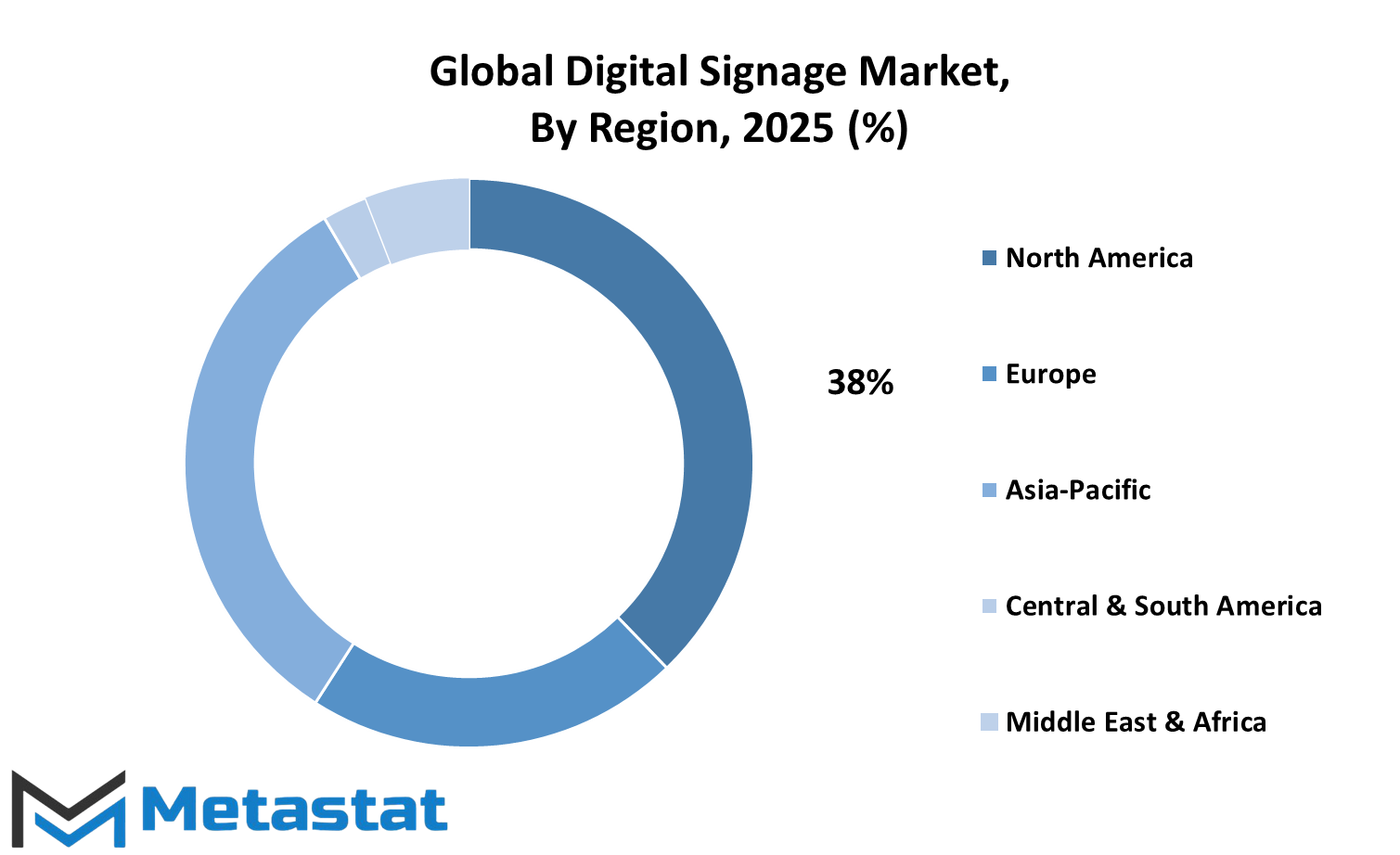MARKET OVERVIEW
The global digital signage market is an evolving sector within the overall technology and communication industry, characterized by the melding of digital display systems with content management technologies in commercial and institutional settings. This market is an expression of the intersection of visual communication, software development, and customer interaction strategies for public-oriented messaging across retail, healthcare, education, transportation, and hospitality sectors.
In the next several years, the global digital signage market will reflect an environment where data-driven content and real-time responsiveness are a given. This market differs from static signage in that it embodies the shift toward intelligent networks of displays able to provide automated content delivery based on behavioral, demographic, or environmental stimuli. It will no longer be confined to flat-panel screens in high-traffic areas. It will move towards more interactive and immersive installations with the use of AI-enabled personalization, sensor systems, and adaptive display technology.
Digital signage will still be utilized not just for advertisement or direction-finding but as a channel for more meaningful audience engagement. In retail and public sector industries, digital screens will serve as interfaces, not just passive information boards. The hardware level be it LED, OLED, or projection-based will be synchronized with cloud-based content systems to enable fluid communication between consumer and brand. Institutions will start using such infrastructure not just for visual branding but for decentralized communication, live updates, and real-time service optimization as well.
Geographically, the global digital signage market will exhibit high variation in technology adoption, based on digital maturity, regulatory requirements, and investment propensity across regions. Urban areas will serve as hotspots for innovation, with installations spilling into semi-urban and infrastructure-dense areas. In developing economies, market development will be stimulated not just by the availability of products but by the sustainable incorporation of digital communication into daily transactions and public engagement systems.
The global digital signage market architectural basis will shift from hardware-based models to service-based ones. The change will introduce new issues in standardization, interoperability, and security. The focus will be on content lifecycle management, data analytics, and user interface customization, encouraging vendors to transcend traditional display systems. Collaborations between display makers, software developers, and network services providers will become critical in enabling scalable and resilient signage networks.
In addition, the sector will put greater emphasis on energy efficiency, sustainable material usage, and device lifecycle responsibility in sync with wider digital responsibility efforts. As display networks become more complex and extensive, asset management will depend greatly on predictive diagnostics and centralized control systems. Businesses will favor platforms that enable effortless integration with IoT systems, consumer feedback loops, and location-based engagement plans.
Eventually, the global digital signage market will become a content-sensitive, contextualized, and cloud-enabled infrastructure. It will be at the nexus of digital communication, experiential design, and intelligent automation. As innovation keeps pushing the boundaries of what digital signage is capable of accomplishing, the market will not merely grow in size but also in importance as a cornerstone of contemporary public and commercial communication environments.
Global digital signage market is estimated to reach $32,916.58 Million by 2032; growing at a CAGR of 6.4% from 2025 to 2032.

GROWTH FACTORS
The global digital signage market is expected to grow steadily in the years ahead, influenced by changing consumer behavior and increasing demand for interactive content. As businesses continue to adopt smarter communication tools, digital signage is becoming a popular choice for advertising, information sharing, and customer engagement. This technology allows for real-time updates and dynamic content, which can be tailored to specific audiences in various settings like retail, transportation, and healthcare. With more organizations investing in digital transformation, the use of digital screens for visual communication is becoming more common and impactful.
One of the key driving factors of the market is the rising need for better customer engagement. Businesses are focusing on creating personalized and visually appealing content that catches attention quickly. Digital signage offers an effective way to do this by combining graphics, video, and data to deliver messages clearly and efficiently. Another important factor is the declining cost of display technology. As screens become more affordable and advanced, more companies large and small are able to implement digital signage solutions without straining their budgets. This wider accessibility is helping push the market forward.
However, high initial setup costs for advanced systems and technical issues related to software integration might hamper market growth. Smaller businesses, in particular, may struggle with the upfront investment and ongoing maintenance of complex systems. Also, some regions may face challenges due to poor internet infrastructure, which is crucial for managing and updating content remotely. These obstacles could slow down the pace at which digital signage is adopted in certain areas.
On the positive side, growing interest in artificial intelligence and data analytics would provide lucrative opportunities for the market in the coming years. AI-powered signage can adjust content automatically based on viewer behavior or time of day, creating a more targeted experience. As this kind of smart functionality becomes more mainstream, it will add significant value to digital signage solutions. Moreover, the rise of smart cities and the push for connected public spaces are expected to open new possibilities for the market, making digital signage a central tool for communication in future urban environments.
Looking ahead, the global digital signage market will likely play a larger role in how people receive and interact with information. With continued innovation and a growing focus on digital engagement, the market has strong potential for long-term success.
MARKET SEGMENTATION
By Type
The global digital signage market is growing steadily and will likely continue to expand in the coming years due to ongoing advances in display technology and the rising need for effective communication tools. Digital signage is used to display information, advertisements, and interactive content in public and private spaces. It has become an important part of how businesses communicate with customers, as it offers a more engaging way to deliver messages. One of the reasons for this growth is the increasing use of visual content to capture attention and influence decision-making.
Looking ahead, the future of the global digital signage market will be shaped by how different display types evolve and meet the changing needs of various industries. The market, by type, includes categories such as video walls, video screens, transparent LED screens, digital posters, kiosks, and others. Each of these types serves a specific purpose and has its own set of benefits. Video walls, for example, offer large-scale displays that can be used in control rooms, malls, or conference centers to provide detailed and eye-catching visuals. As technology improves, these walls will become slimmer, more energy-efficient, and more adaptable to different environments.
Video screens are commonly seen in public transportation hubs, stores, and office buildings. They are expected to become more responsive and interactive, allowing users to receive tailored content based on their behavior or preferences. Transparent LED screens are still developing but hold great potential for modern architecture and product showcases, giving a futuristic feel while still being functional. In retail, they will likely change how window displays are done, offering real-time updates without blocking the view of the products behind them.
Digital posters are a flexible option for short-term promotions or announcements. As printing becomes less necessary, digital posters will take over more traditional print areas, cutting down costs and waste. Kiosks are also gaining popularity in places like airports, hospitals, and banks. These allow users to interact directly with the screen, check in, or find directions without the need for staff help. In the future, more kiosks will include features like facial recognition and voice interaction.
Overall, the global digital signage market will move toward smarter, more personalized solutions. With technology growing more intelligent, businesses will rely on digital signage not just to inform, but also to understand and respond to their audiences in real time. This shift will create new opportunities across industries while also setting new standards for digital communication.
By Technology
The global digital signage market is expected to grow steadily in the years to come, driven by constant advancements in display technologies and the increasing demand for dynamic visual communication. Digital signage has already made its way into retail stores, transportation hubs, corporate offices, healthcare settings, and public spaces. It allows for content to be updated quickly and tailored to specific audiences. This flexibility has made it a useful tool for businesses that want to improve customer engagement, share information more clearly, or promote their services. As technology moves forward, digital signage will likely become even more interactive and personalized.
By looking at the technology behind it, the market is mainly split into LCD, LED, OLED, and Projection. LCD displays are still widely used because they offer a good balance of cost, image quality, and durability. They are ideal for indoor environments where consistent visuals are needed. LED technology, on the other hand, is preferred for brighter displays and larger screens, especially in outdoor settings. It provides excellent visibility from a distance and works well in different lighting conditions. OLED screens offer better contrast and richer colors, which makes them popular for high-end displays, though they are currently more expensive than other options. Projection-based digital signage has also found a place in creative displays, offering flexible screen sizes and formats that can adapt to various spaces.
Looking ahead, technology will keep changing how digital signage works. Artificial intelligence will likely play a larger role, helping displays adjust in real time based on who is watching or the time of day. Touchless controls, gesture recognition, and even voice commands could soon become normal features. Energy efficiency will also matter more, encouraging the use of displays that use less power without losing performance. As 5G networks spread, digital signage systems will be able to update content faster and manage many displays at once without delays.
This growth will not just benefit businesses but also change how people experience public and private spaces. Information will be easier to access, advertising will feel more relevant, and communication will become more immediate. As the global digital signage market continues to evolve, the combination of better technology, smarter systems, and wider use will shape a future where digital displays play a bigger role in how we interact with our surroundings.
By Location
The global digital signage market is expected to grow steadily as more industries adopt digital displays to share content in smarter, more dynamic ways. These signs are no longer just flat screens in shop windows. They are now interactive tools used to guide, inform, and connect with people in different environments. From retail stores and restaurants to airports and public spaces, digital signage is becoming an essential part of how information is delivered.
Looking ahead, the market will continue to evolve as technology improves and costs go down. Businesses will shift from printed ads to digital content that can change in real-time, offering flexibility and better audience engagement. One major change is the growing interest in location-based applications. The global digital signage market is now divided into two key areas: indoor and outdoor. This helps businesses choose the right kind of setup for their needs and environments.
Indoor digital signage includes displays used in malls, hotels, offices, hospitals, and schools. These signs will become more personalized as AI and data analytics are used to tailor messages based on time of day, audience type, or even individual preferences. For example, a display in a shopping mall might change depending on who walks past it, using sensors or connected apps. This kind of smart interaction will make indoor signage more powerful in influencing decisions.
Outdoor signage, on the other hand, needs to be more durable and visible in various weather conditions and lighting. Think of large screens on streets, stadiums, or transit systems. These displays will continue to grow in size and resolution while using solar power or energy-saving methods to reduce costs. With the rise of smart cities, outdoor digital signage will also work with traffic systems, emergency alerts, and public information campaigns. As 5G expands, faster connections will make updates and changes to outdoor signs nearly instant.
In the future, the global digital signage market will also see more use of touchscreens, voice commands, and motion sensors, making digital signs more than just display boards. They will become tools for interaction. This shift will not only improve user experience but also offer new ways for businesses to gather useful data about customer behavior. As the demand for flexible and responsive communication grows, digital signage will be seen as a smart investment rather than an extra cost.
This market has a strong future, and its potential is just beginning to show. Both indoor and outdoor locations will continue to drive innovation, making digital signage a key part of the modern communication landscape.
By End User
The global digital signage market will continue to grow as digital communication becomes more important in daily life. Digital signage, which involves the use of screens and digital displays to share content, is already seen in many public and private places. In the coming years, this market will likely expand further due to rising demand for smart and connected display systems. More industries are finding value in using digital signs for real-time updates, branding, and customer interaction.
One of the key areas where digital signage is gaining ground is education. Schools and universities are turning to digital displays to share announcements, event schedules, emergency information, and even learning content. These displays allow messages to be changed quickly without needing printed materials, which helps save time and money. As more learning spaces become digitally connected, this trend will continue.
In healthcare, digital signage is being used in hospitals and clinics to guide patients, show wait times, and provide health tips. This makes visits easier and helps both patients and staff stay informed. In the future, hospitals may use screens to share real-time updates from doctors or to offer personalized messages to patients.
The corporate sector is also investing in digital signage to improve internal communication and customer-facing services. Offices are using displays in lobbies and meeting rooms to show updates, schedules, and branding content. As more companies adopt flexible work styles, these digital tools will be useful for keeping employees and visitors connected.
Stadiums are already using large digital screens for scores and advertisements, but in the years to come, they could offer interactive experiences. Fans might be able to use their phones to connect with the displays for instant replays or exclusive content, enhancing the live experience.
Government buildings are starting to use digital signs for public notices, traffic alerts, and service information. This is expected to grow as cities aim to become smarter and more connected. These signs can be updated remotely, helping local offices share accurate and timely information.
Retail has been a major driver for digital signage, and it will keep evolving. Stores use displays to promote products, share offers, and improve the shopping experience. As consumer habits shift and people look for personalized content, retailers will continue to upgrade their signage systems.
Other industries, including transportation and hospitality, are exploring digital signage to support service delivery. As technology improves and prices drop, more organizations will find it easier to adopt these tools, supporting further growth in the global digital signage market.
|
Forecast Period |
2025-2032 |
|
Market Size in 2025 |
$21,441.19 million |
|
Market Size by 2032 |
$32,916.58 Million |
|
Growth Rate from 2025 to 2032 |
6.4% |
|
Base Year |
2024 |
|
Regions Covered |
North America, Europe, Asia-Pacific Green, South America, Middle East & Africa |
REGIONAL ANALYSIS
The global digital signage market is moving toward a future shaped by expanding technology, growing demand for real-time communication, and changing consumer behavior. Across all regions North America, Europe, Asia-Pacific, South America, and the Middle East & Africa businesses are using digital displays to connect with people more effectively. As the need for dynamic and interactive content rises, the digital signage industry is expected to become a key part of marketing, information sharing, and customer engagement.
In North America, especially in the U.S., Canada, and Mexico, digital signage is already a strong force in retail, healthcare, and education. Companies there will likely keep investing in smarter displays, improved content management systems, and personalized advertising tools. As digital signs become more responsive and data-driven, businesses across this region are expected to adopt these tools not just for promotions but also for public safety updates and workplace communication.
In Europe, countries like the UK, Germany, France, and Italy are turning to digital signage to improve the customer experience in places such as transportation hubs, shopping centers, and offices. These countries are also making efforts to ensure energy-efficient technologies are used in public and private sectors, which will further support the shift to smarter display systems. The rest of Europe is following this trend, showing strong interest in touchless technology and screen networks that adjust content based on audience behavior.
Asia-Pacific, including India, China, Japan, and South Korea, is expected to see rapid growth. Urban development and strong digital infrastructure are pushing the demand for digital signage in transportation, government services, and education. In particular, China and India are likely to become major users due to their population size and increasing focus on smart cities. South Korea and Japan, being technology leaders, will keep pushing innovation with advanced displays and AI-powered content.
In South America, especially in Brazil and Argentina, more businesses are realizing the benefits of using digital signage for advertising and information sharing. The region will gradually embrace newer formats and cloud-based solutions as infrastructure improves. Similarly, in the Middle East & Africa particularly in GCC Countries, Egypt, and South Africa there is a growing interest in digital communication tools. This interest is tied to both retail expansion and public sector investment in technology.
As all regions move forward, the global digital signage market will continue to grow, shaped by innovation, shifting expectations, and a drive for more engaging and flexible communication methods.

COMPETITIVE PLAYER
The global digital signage market is steadily growing and shows no signs of slowing down. As technology becomes more deeply woven into everyday life, digital signage has moved from being a novelty to a vital part of communication strategies for many businesses. From storefronts and transportation hubs to healthcare centers and corporate offices, these displays are becoming standard tools for delivering real-time information, advertisements, and interactive experiences. They’re not just replacing traditional signs; they’re opening up new ways for companies to connect with people. The ability to update content remotely, personalize messages, and grab attention through motion and vibrant visuals makes digital signage a smart and flexible solution.
Looking ahead, this market will likely become even more important. Future developments are expected to push digital signage beyond simply showing static or looping content. Advances in artificial intelligence, machine learning, and sensors will allow displays to respond to the environment or even to individuals nearby. This shift toward smarter and more adaptive signage means advertisers and organizations will be able to reach people more effectively, making interactions more relevant and engaging. As cities move toward smart infrastructure and businesses become more data-driven, digital signage will play a larger role in gathering and reacting to data in real-time.
Some of the most well-known companies driving this change include Samsung Electronics, LG Electronics, NEC Corporation, Sony Corporation, and Panasonic Corporation. These industry giants have been consistent in developing high-resolution screens and powerful software to support complex display networks. Sharp Corporation, Leyard Optoelectronic (Planar Systems), Cisco Systems, and Intel Corporation are also contributing by creating the hardware and infrastructure needed to support smarter displays. In addition, firms like BrightSign, AOPEN, Scala (a STRATACACHE company), STRATACACHE, Navori Labs, Broadsign, Signagelive, ViewSonic Corporation, and Peerless-AV are bringing new ideas and pushing software capabilities that will likely shape the next wave of digital signage experiences.
In the years to come, the global digital signage market will likely benefit from growing investments in smart cities, rising demand for contactless communication, and the increasing need for real-time updates in public and private spaces. As these trends take shape, digital signage will no longer be seen as just a screen on a wall but as a smart, responsive tool that changes how information is shared and how people interact with spaces around them.
Digital Signage Market Key Segments:
By Type
- Video Walls
- Video Screens
- Transparent LED Screens
- Digital Posters
- Kiosks
- Others
By Technology
- LCD
- LED
- OLED
- Projection
By Location
- Indoor
- Outdoor
By End User
- Education
- Healthcare
- Corporate
- Stadiums
- Government
- Retail
- Others
Key Global Digital Signage Industry Players
- Samsung Electronics
- LG Electronics
- NEC Corporation
- Sony Corporation
- Panasonic Corporation
- Sharp Corporation
- Leyard Optoelectronic (Planar Systems)
- Cisco Systems
- Intel Corporation
- BrightSign
- AOPEN
- Scala (a STRATACACHE company)
- STRATACACHE
- Navori Labs
- Broadsign
- Signagelive
- ViewSonic Corporation
- Peerless-AV
WHAT REPORT PROVIDES
- Full in-depth analysis of the parent Industry
- Important changes in market and its dynamics
- Segmentation details of the market
- Former, on-going, and projected market analysis in terms of volume and value
- Assessment of niche industry developments
- Market share analysis
- Key strategies of major players
- Emerging segments and regional growth potential








 US: +1 3023308252
US: +1 3023308252






